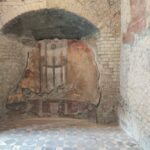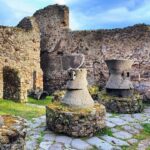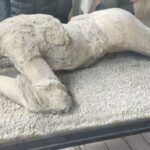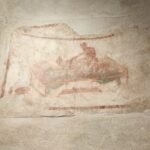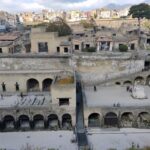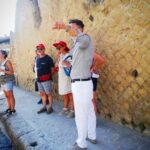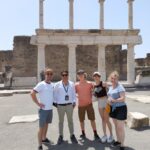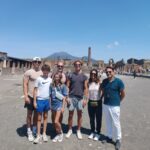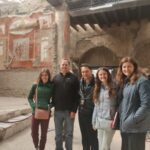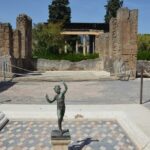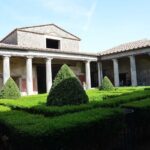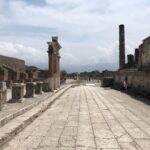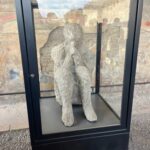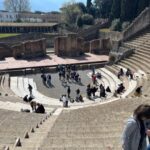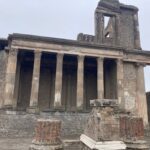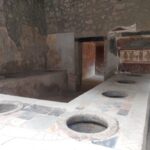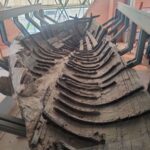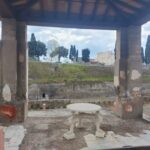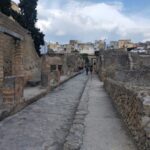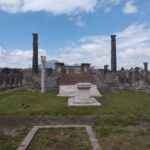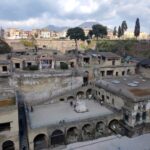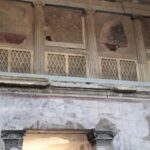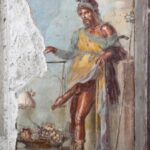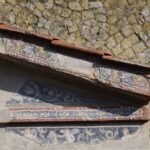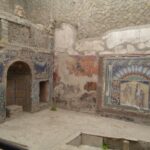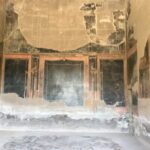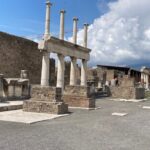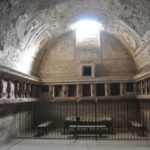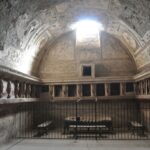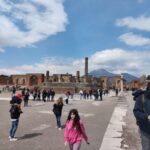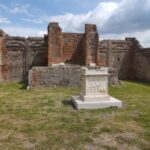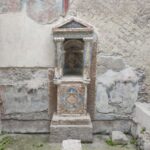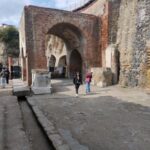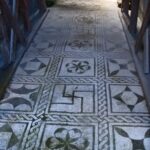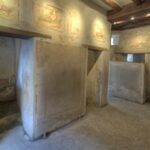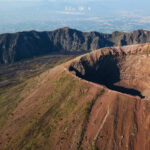Pompeii and Mount Vesuvius.
Full day tour. The tour includes Private trasportation by a van driven by a professional driver
Being an archaeologist, I excavated a house in Pompeii with my university professor. An incredible experience that I will always carry with me. Pompeii for me is simply a magical place that will leave you with an unforgettable memory of how a Roman city was made in all its public, private, civil, and religious aspects.
Pompeii was an ancient Roman city located near modern Naples in Italy. Its history dates back to around the 7th century BC when it was founded by the Oscans, an Italic tribe. Initially, it was a small agricultural community, but it grew over time into a prosperous and bustling city, largely due to its strategic location near the Bay of Naples and its fertile volcanic soil.
The history of Pompeii:
-
Greek Influence: Before becoming a Roman city, Pompeii was influenced by Greek culture, as were many other cities in the region. The Greeks established trading posts in southern Italy, including Pompeii, which contributed to the city’s cultural development.
-
Roman Conquest: In the 5th century BC, Pompeii came under the control of the Samnites, another Italic tribe. However, by the 4rd century BC, it was absorbed into the expanding Roman Republic during the Samnite Wars. Under Roman rule, Pompeii flourished as a commercial and trading hub.
-
Prosperity and Urban Development: During the 1st century BC, Pompeii experienced a period of significant growth and prosperity. The city expanded, and many public buildings, temples, theaters, and lavish villas were constructed. Pompeii became a vibrant center of commerce, art, and culture.
-
Mount Vesuvius Eruption: One of the most significant events in Pompeii’s history occurred on August 24, 79 AD, when Mount Vesuvius, the nearby volcano, erupted catastrophically. The eruption buried Pompeii and several other nearby towns under a thick layer of volcanic ash and pumice, preserving them remarkably well for centuries.
-
Rediscovery: Pompeii remained buried and largely forgotten for centuries until its rediscovery in the 18th century. Excavations began in the mid-18th century and have continued to the present day, revealing invaluable insights into daily life in ancient Rome.
-
Archaeological Site: Today, Pompeii is an archaeological site of immense historical and cultural significance. It attracts millions of visitors each year who come to explore its remarkably preserved ruins, streets, buildings, and artifacts. Pompeii provides a fascinating glimpse into the daily life, architecture, art, and society of ancient Rome.
Overall, Pompeii’s history is a tale of prosperity, destruction, and rediscovery, offering a unique window into the ancient world.
ITINERARY
in Pompeii:
– The big theatre
– The small theatre
– A bakery shop
– The house of the Ceii
– The house of the Menander
– the main street named Abbondanza street
– A roman fast food
– The Stabian bathhouse
– The brothel
– The main square
– The plastercasts of the victims
•The order might change
– Mount Vesuvius:
The Mount Vesuvius is one of the most famous and active volcanoes in the world, spans thousands of years. Here’s an overview:
-
Formation: Mount Vesuvius is a stratovolcano located on the Gulf of Naples in Italy. It is part of the Campanian volcanic arc, which includes other famous volcanic structures such as Mount Etna and Stromboli. The volcano formed over the course of hundreds of thousands of years through the accumulation of lava flows, ash, and volcanic debris.
-
Early History: Vesuvius has been active for at least 17,000 years, with evidence of eruptions dating back to the Paleolithic period. The earliest recorded eruption occurred around 3,700 BC. Over the centuries, Vesuvius experienced numerous eruptions, alternating between periods of activity and dormancy.
-
79 AD Eruption: The most infamous event in Vesuvius’s history occurred in 79 AD when it erupted catastrophically, burying the Roman cities of Pompeii, Herculaneum, and several other settlements in the region under a thick layer of volcanic ash and debris. The eruption, which lasted for about 24 hours, was one of the deadliest in recorded history and resulted in the deaths of thousands of people. It also preserved the towns remarkably well, providing invaluable insights into ancient Roman life.
-
Subsequent Eruptions: Vesuvius continued to erupt periodically in the centuries that followed, with notable eruptions occurring in 472 AD, 1631, and 1944, among others. These eruptions often caused significant damage to nearby settlements and occasionally claimed lives.
-
Modern Monitoring and Impact: Today, Vesuvius is closely monitored by volcanologists to track its activity and assess potential risks to the surrounding population. The region surrounding the volcano is densely populated, including the city of Naples and several towns and villages on its slopes. Efforts are underway to develop evacuation plans and emergency response measures in the event of future eruptions.
-
Tourism and Cultural Significance: Despite its destructive potential, Mount Vesuvius is a popular tourist destination, attracting visitors from around the world who come to marvel at its scenic beauty and learn about its history. The volcano has also left a lasting cultural impact, influencing art, literature, and scientific inquiry for centuries.
Overall, the history of Mount Vesuvius is a testament to the power and unpredictability of nature, as well as the resilience of human communities living in its shadow.
Once you reach an altitude of 1000 meters with the van, you will continue along the Gran Cono path to reach the top of the 1281 meter high volcano. The trail is approximately 4 kilometers long with a travel time of approximately 1 hour and 45 minutes to go up and back.
*This tour can be customized
MEETING POINT + TOUR DURATION
Meeting Point Options: Rail or Bus Station, Cruise Ship Port, Airport, Hotel
Duration: 7 hours 30 min.
TRANSPORTATION
It’s a walking tour in the Ruins and on the Vesuvis. To get and to come back to the Mount we are using a private taxi.
WHAT’S INCLUDED
- Guiding Services
- Private Transportation
Other: The tour includes the taxi service from Herculaneum to the Vesuvius and the return from the Vesuvius to Herculaneum. It is valid for up to 7 people.
ESTIMATED LOCAL CASH NEEDED
29 € in total:
– 18 € admission fee for Pompei;
– 11 € admission fee for the Mount Vesuvius
Prices are per person.
WHAT’S EXTRA
- Personal Expenses
- Souvenirs
- Food, Drinks, Snacks



